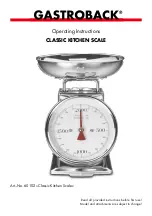
© Adam Equipment Company 2009
Page 12
Rev C3, June 2008
8.3
When Parameter S.F. in section 7 is set to 1 :
Continuous output of the current displayed reading and unit, and it does not receive
any data. The output format is as below:
<LF>< reading, minus, decimal point, weight unit>GR<CR><EXT>
Or <LF>< reading, minus, decimal point, weight unit>NT<CR><EXT>
8.4
When Parameter S.F. in section 7 is set to 2 :
Manually outputs display data when PRINT is pressed. The output format is as
below:
<LF>< reading, minus, decimal point, weight unit>GR<CR><EXT>
Or <LF>< reading, minus, decimal point, weight unit>NT<CR><EXT>
8.5
When Parameter S.F. in section 7 is set to 3 :
The baud rate and data format are fixed with responses to serial commands being
within 300 milliseconds. One second should be adequate for use as a time-out
value by remote (controlling) device.
8.5.1
The length of the weight field will be 7 digit weight data, one for minus sign,
one for decimal point, two for measure unit (e.g. “lb”, “kg”). Units of measure
abbreviations are always lower case.
If the weight is overcapacity, the scale will return nine ‘^’ characters (the field of
minus sign, decimal point, weight data is filled by ‘^’).
If the weight is under capacity, it will return nine ‘-’ characters (the field of minus
sign, decimal point, and weight data is filled by ‘_’).
If the zero point has an error, it will return nine ‘-’ characters.
The character will be ‘-’ for negative weight or a space character for positive
weight. Minus sign follows after the first digit.
Useless leading zero before digits are suppressed.
8.5.2
Key to symbols used
<LF> Line Feed character (hex 0AH)
<CR> Carriage Return character (hex 0DH)
<ETX> End of Text character (hex 03)
<SP> Space (hex 20H)
H1H2H3 Three status bytes. Refer to Table1 for definition.





































